Abstract
Dose-response relationships between blood lead levels and toxic effects have been evaluated in 160 lead workers in two smelters and a chemicals plant. Blood lead levels ranged from 0.77 to 13.51 mumol/litre (16-280 microgram/dl). Clinical evidence of toxic exposure was found in 70 workers (44%), including colic in 33, wrist or ankle extensor muscle weakness in 12, anaemia (Hgb less than 8.69 mumol/litre (Hb/4) or 14.0 gm/dl) in 27, elevated blood urea nitrogen (greater than or equal to 7.14 mmol/litre or 20 mg/dl) in 28, and possible encephalopathy in two. No toxicity was detected at blood lead levels below 1.93 mumol/litre (40 microgram/dl). However, 13% of workers with blood lead levels of 1.93 to 3.81 mumol/litre (40-79 microgram/dl) had extensor muscle weakness or gastrointestinal symptoms. Anaemia was found in 5% of workers with lead levels of 1.93-2.85 mumol/litre (40-59 microgram/dl), in 14% with levels of 2.90 to 3.81 mumol/litre (60-79 microgram/dl), and in 36% with levels greater than or equal to 3.86 mumol/litre (80 microgram/dl). Elevated blood urea nitrogen occurred in long-term lead workers. All but three workers with increased blood urea nitrogen had at least four years occupational lead exposure, and nine had received oral chelation; eight of this group had reduced creatinine clearance, and eight had decreased renal concentrating ability. These data support the establishment of a permissible biological limit for blood lead at a level between 1.93 and 2.90 mumol/litre (40-60 microgram/dl).
Full text
PDF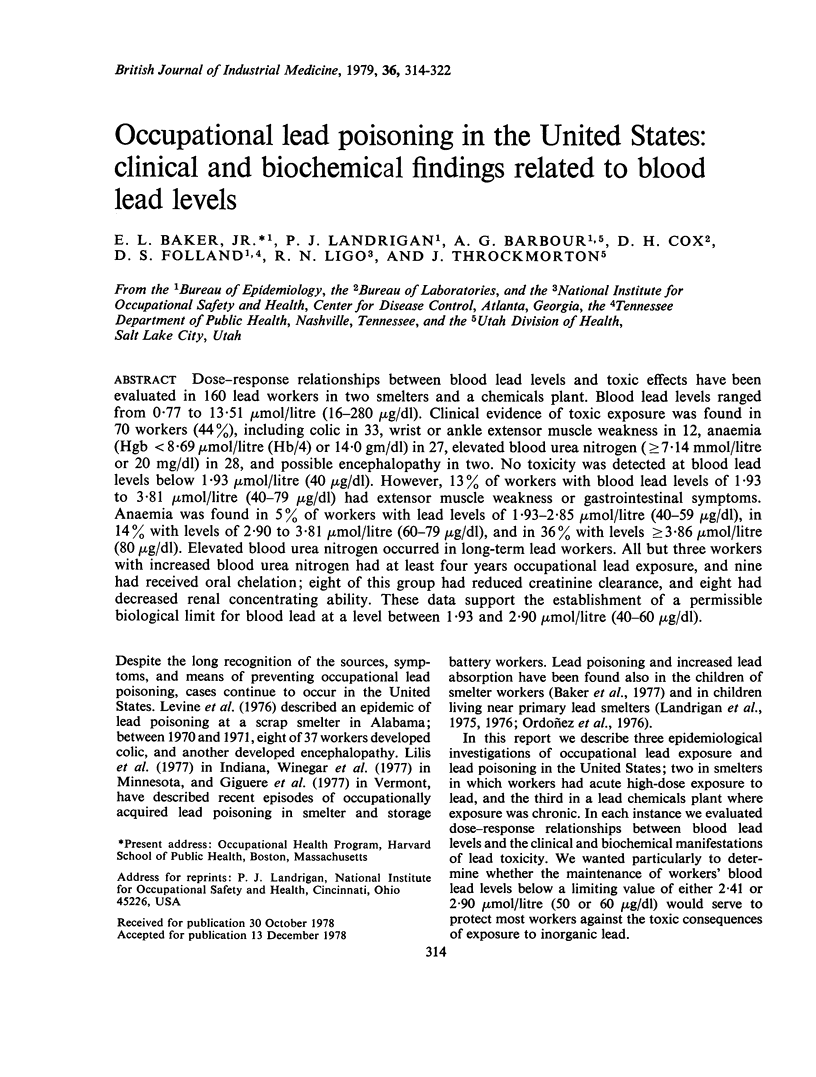

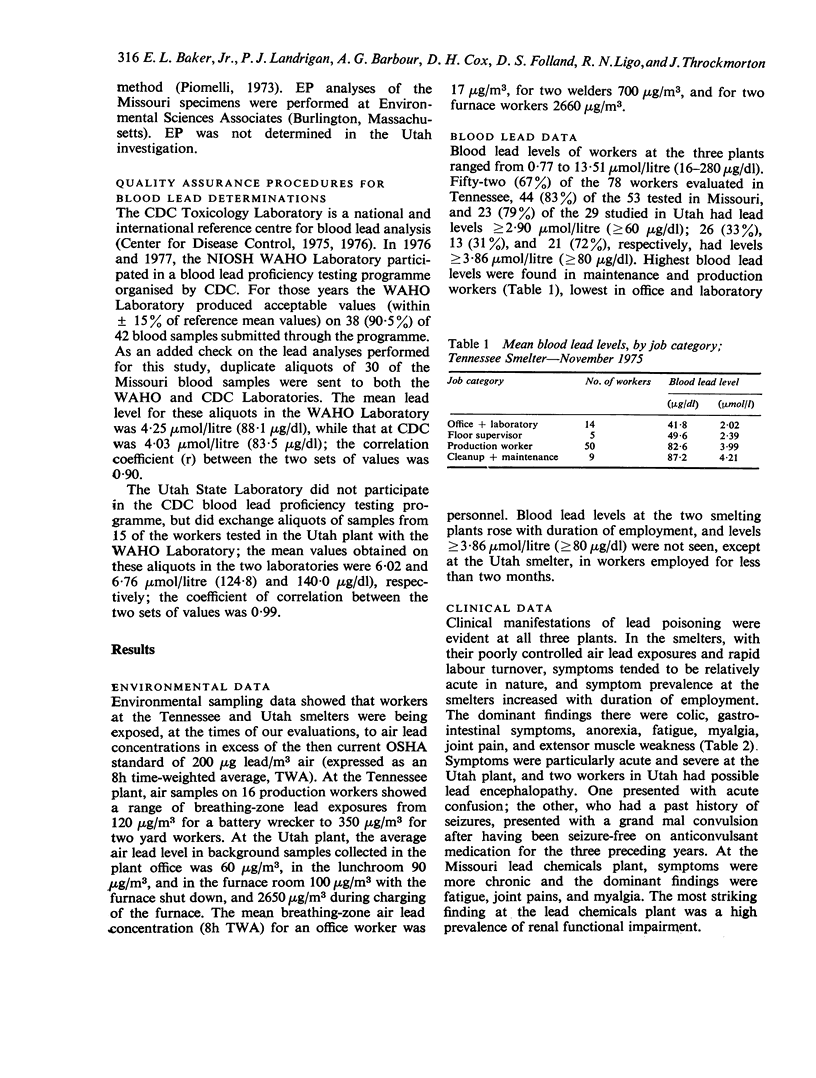
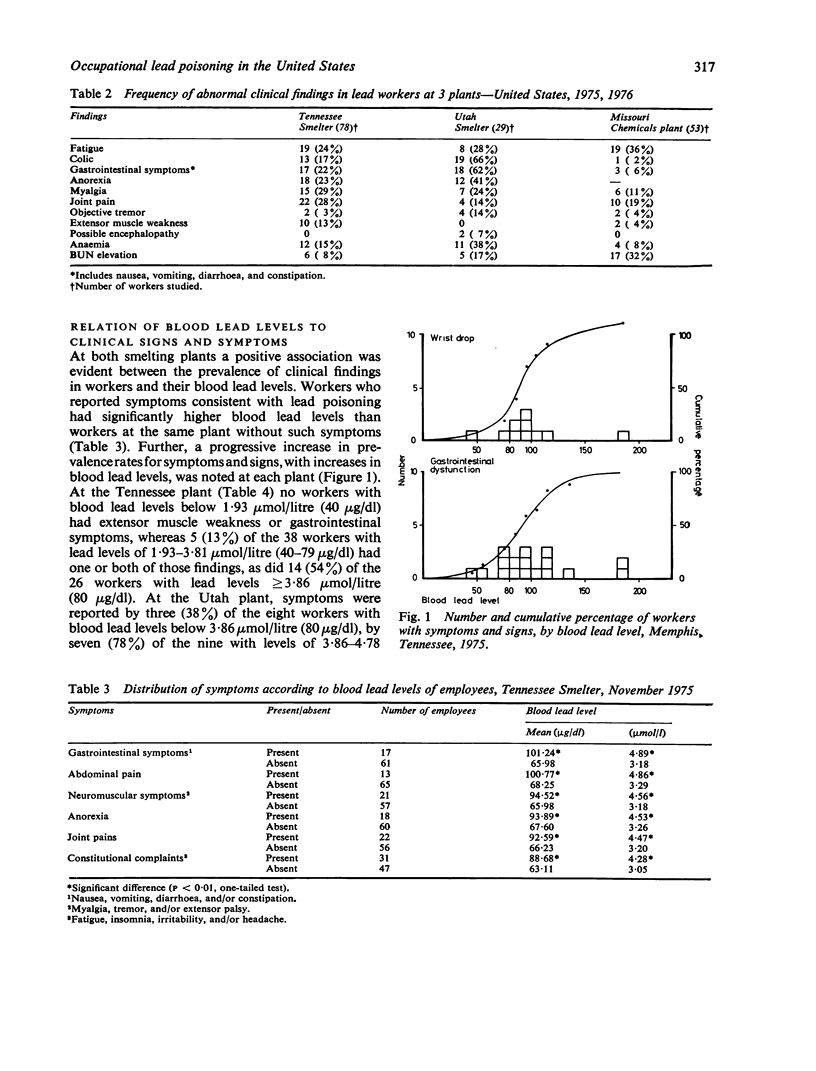
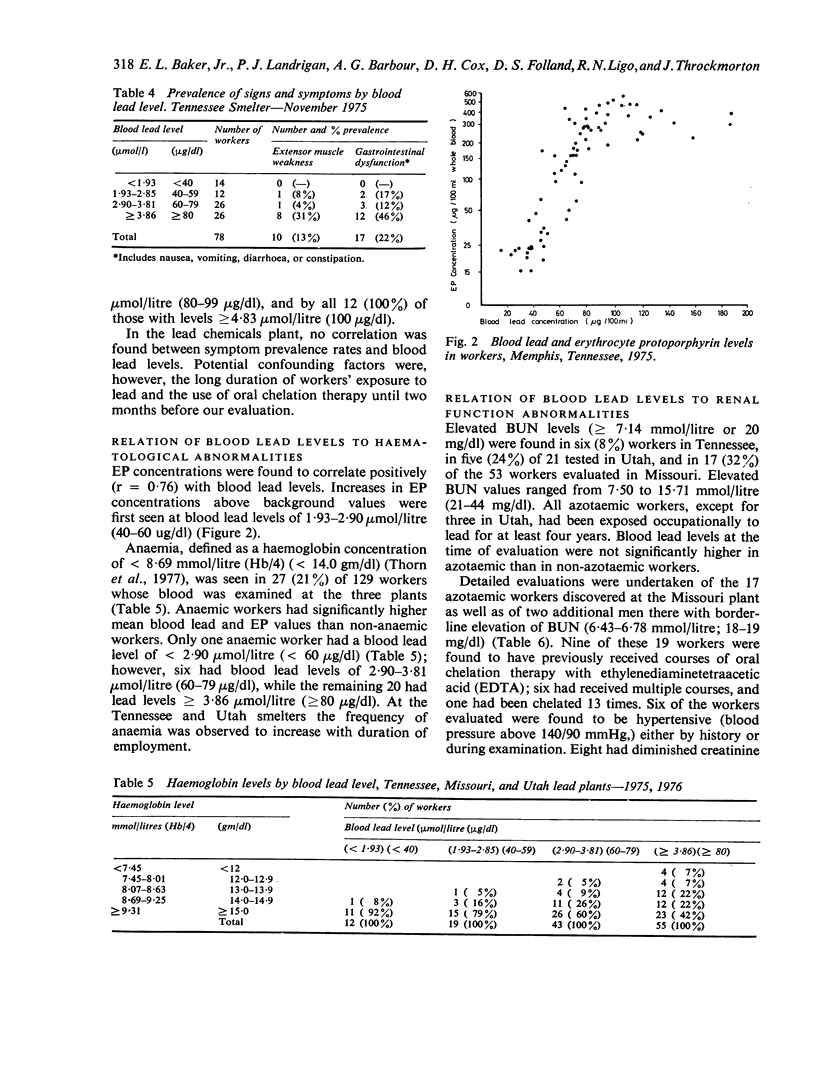
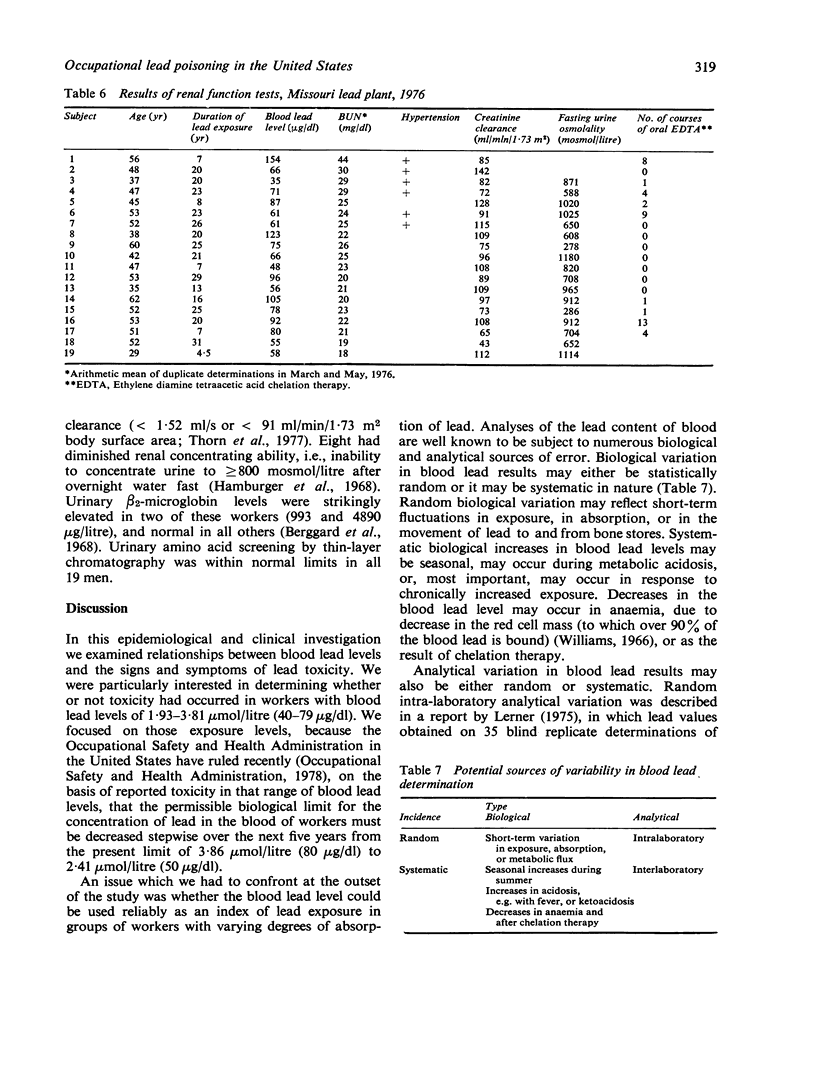
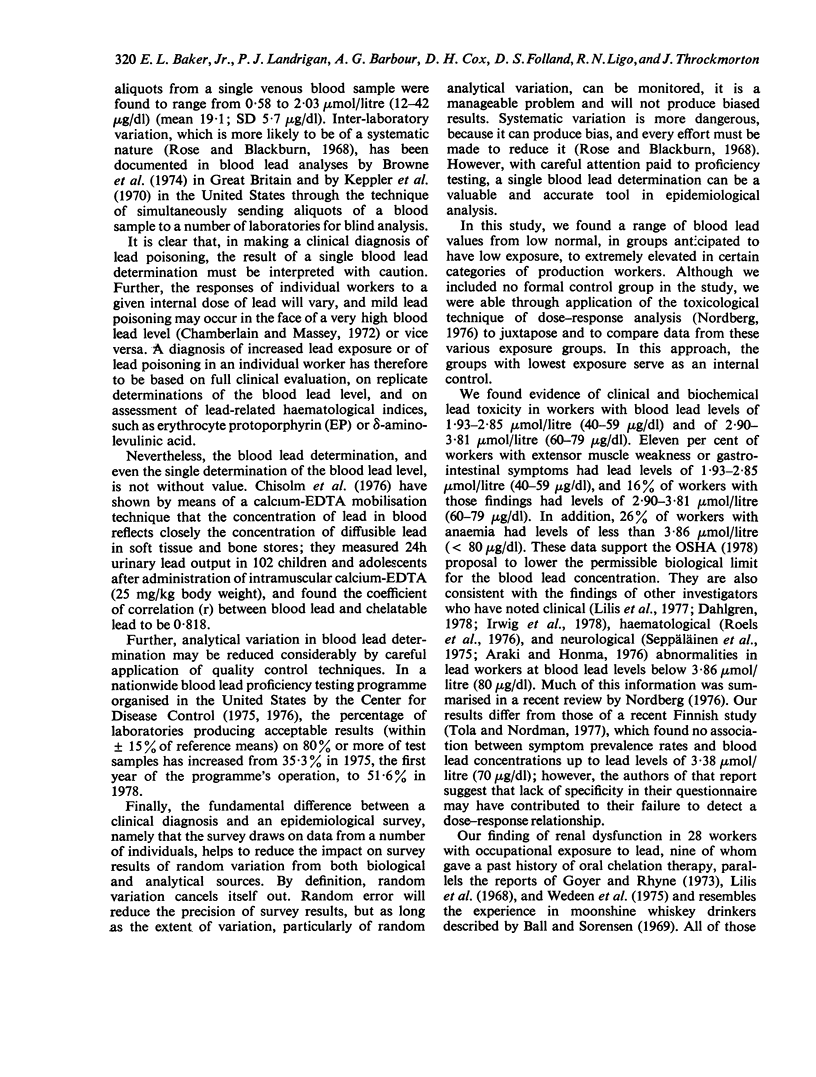
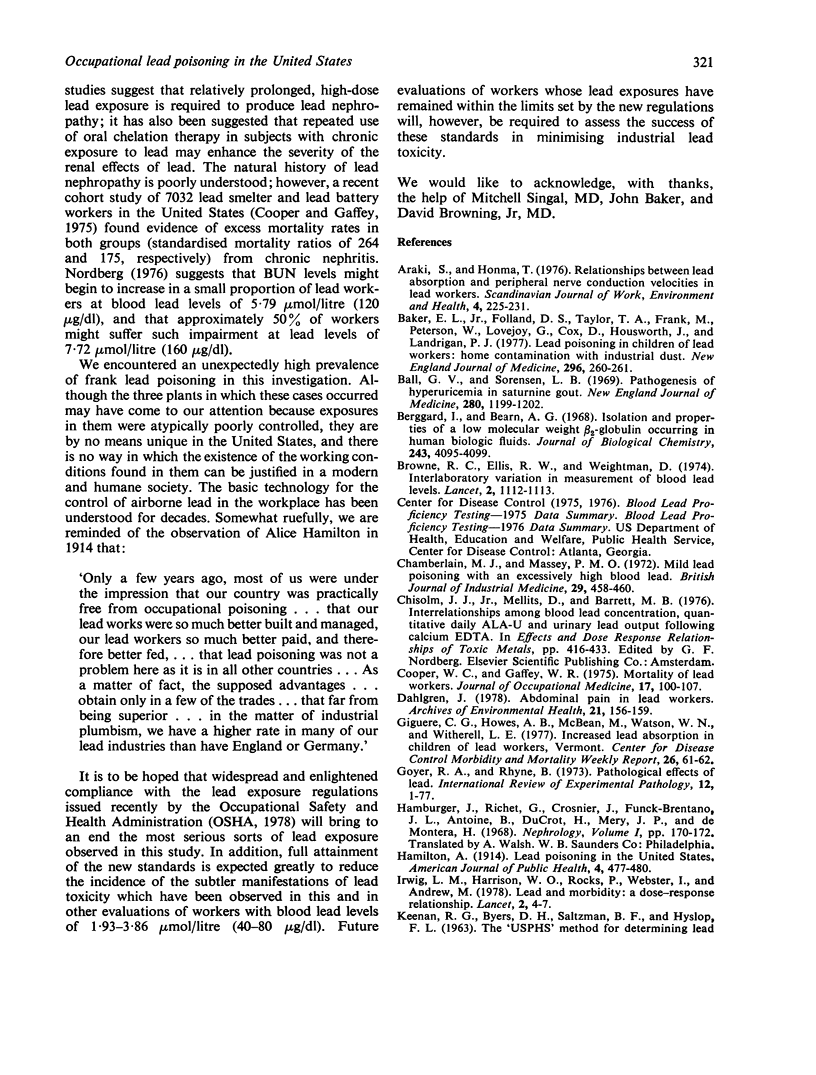

Selected References
These references are in PubMed. This may not be the complete list of references from this article.
- Araki S., Honma T. Relationships between lead absorption and peripheral nerve conduction velocities in lead workers. Scand J Work Environ Health. 1976 Dec;2(4):225–231. doi: 10.5271/sjweh.2800. [DOI] [PubMed] [Google Scholar]
- Baker E. L., Folland D. S., Taylor T. A., Frank M., Peterson W., Lovejoy G., Cox D., Housworth J., Landrigan P. J. Lead poisoning in children of lead workers: home contamination with industrial dust. N Engl J Med. 1977 Feb 3;296(5):260–261. doi: 10.1056/NEJM197702032960507. [DOI] [PubMed] [Google Scholar]
- Ball G. V., Sorensen L. B. Pathogenesis of hyperuricemia in saturinine gout. N Engl J Med. 1969 May 29;280(22):1199–1202. doi: 10.1056/NEJM196905292802203. [DOI] [PubMed] [Google Scholar]
- Berggård I., Bearn A. G. Isolation and properties of a low molecular weight beta-2-globulin occurring in human biological fluids. J Biol Chem. 1968 Aug 10;243(15):4095–4103. [PubMed] [Google Scholar]
- Browne R. C., Ellis R. W., Weightman D. Inter-laboratory variation in measurement of blood-lead levels. Lancet. 1974 Nov 9;2(7889):1112–1113. doi: 10.1016/s0140-6736(74)90871-x. [DOI] [PubMed] [Google Scholar]
- Chamberlain M. J., Massey P. M. Mild lead poisoning with an excessively high blood lead. Br J Ind Med. 1972 Oct;29(4):458–460. doi: 10.1136/oem.29.4.458. [DOI] [PMC free article] [PubMed] [Google Scholar]
- Cooper W. C., Gaffey W. R. Mortality of lead workers. J Occup Med. 1975 Feb;17(2):100–107. doi: 10.1097/00043764-197502000-00012. [DOI] [PubMed] [Google Scholar]
- Dahlgren J. Abdominal pain in lead workers. Arch Environ Health. 1978 Jul-Aug;33(4):156–159. doi: 10.1080/00039896.1978.10667327. [DOI] [PubMed] [Google Scholar]
- Goyer R. A., Rhyne B. C. Pathological effects of lead. Int Rev Exp Pathol. 1973;12:1–77. [PubMed] [Google Scholar]
- Hamilton A. LEAD POISONING IN THE UNITED STATES. Am J Public Health (N Y) 1914 Jun;4(6):477–480. doi: 10.2105/ajph.4.6.477-a. [DOI] [PMC free article] [PubMed] [Google Scholar]
- Irwig L. M., Harrison W. O., Rocks P., Webster I., Andrew M. Lead and morbidity: A dose-response relationship. Lancet. 1978 Jul 1;2(8079):4–7. doi: 10.1016/s0140-6736(78)91319-3. [DOI] [PubMed] [Google Scholar]
- KEENAN R. G., BYERS D. H., SALTZMAN B. E., HYSLOP F. L. THE "USPHS" METHOD FOR DETERMINING LEAD IN AIR AND IN BIOLOGICAL MATERIALS. Am Ind Hyg Assoc J. 1963 Sep-Oct;24:481–491. doi: 10.1080/00028896309343251. [DOI] [PubMed] [Google Scholar]
- Keppler J. K., Maxfield M. E., Moss W. D., Tietjen G., Linch A. L. Interlaboratory evaluation of the reliability of blood lead analyses. Am Ind Hyg Assoc J. 1970 Jul-Aug;31(4):412–429. doi: 10.1080/0002889708506268. [DOI] [PubMed] [Google Scholar]
- Landrigan P. J., Baker E. L., Jr, Feldman R. G., Cox D. H., Eden K. V., Orenstein W. A., Mather J. A., Yankel A. J., Von Lindern I. H. Increased lead absorption with anemia and slowed nerve conduction in children near a lead smelter. J Pediatr. 1976 Dec;89(6):904–910. doi: 10.1016/s0022-3476(76)80594-x. [DOI] [PubMed] [Google Scholar]
- Landrigan P. J., Gehlbach S. H., Rosenblum B. F., Shoults J. M., Candelaria R. M., Barthel W. F., Liddle J. A., Smrek A. L., Staehling N. W., Sanders J. F. Epidemic lead absorption near an ore smelter. The role of particulate lead. N Engl J Med. 1975 Jan 16;292(3):123–129. doi: 10.1056/NEJM197501162920302. [DOI] [PubMed] [Google Scholar]
- Lerner S. Blood lead analysis - precision and stability. J Occup Med. 1975 Mar;17(3):153–154. [PubMed] [Google Scholar]
- Levine R. J., Moore R. M., McLaren G. D., Barthel W. F., Landrigan P. J. Occupational lead poisoning, animal deaths, and environmental contamination at a scrap smelter. Am J Public Health. 1976 Jun;66(6):548–552. doi: 10.2105/ajph.66.6.548. [DOI] [PMC free article] [PubMed] [Google Scholar]
- Lilis R., Fischbein A., Eisinger J., Blumberg W. E., Diamond S., Anderson H. A., Rom W., Rice C., Sarkozi L., Kon S. Prevalence of lead disease among secondary lead smelter workers and biological indicators of lead exposure. Environ Res. 1977 Oct;14(2):255–285. doi: 10.1016/0013-9351(77)90037-8. [DOI] [PubMed] [Google Scholar]
- Lilis R., Gavrilescu N., Nestorescu B., Dumitriu C., Roventa A. Nephropathy in chronic lead poisoning. Br J Ind Med. 1968 Jul;25(3):196–202. doi: 10.1136/oem.25.3.196. [DOI] [PMC free article] [PubMed] [Google Scholar]
- Piomelli S. A micromethod for free erythrocyte porphyrins: the FEP test. J Lab Clin Med. 1973 Jun;81(6):932–940. [PubMed] [Google Scholar]
- Raquel Ordóez B., Ruiz Romero L., Mora I. R. Investigacion epidemiológica sobre niveles de plomo en la población infantil y en el medio ambiente domiciliario de ciudad Juarez, Chihuahua, en relación con una fundición de El Paso, Texas. Bol Oficina Sanit Panam. 1976 Apr;80(4):303–317. [PubMed] [Google Scholar]
- Roels H., Bruaux P., Buchet J. P., Claeys-Thoreau F., Lauwerys R., Lafontaine A., Hubermont G., Van Overschelde J. Impact of air pollution by lead on the heme biosynthetic pathway in school-age children. Arch Environ Health. 1976 Nov-Dec;31(6):310–316. doi: 10.1080/00039896.1976.10667241. [DOI] [PubMed] [Google Scholar]
- Seppäläinen A. M., Tola S., Hernberg S., Kock B. Subclinical neuropathy at "safe" levels of lead exposure. Arch Environ Health. 1975 Apr;30(4):180–183. doi: 10.1080/00039896.1975.10666672. [DOI] [PubMed] [Google Scholar]
- Tola S., Nordman C. H. Subjective symptoms and exposure to lead. Int Arch Occup Environ Health. 1977 Nov 29;40(3):153–162. doi: 10.1007/BF01842076. [DOI] [PubMed] [Google Scholar]
- Wedeen R. P., Maesaka J. K., Weiner B., Lipat G. A., Lyons M. M., Vitale L. F., Joselow M. M. Occupational lead nephropathy. Am J Med. 1975 Nov;59(5):630–641. doi: 10.1016/0002-9343(75)90224-7. [DOI] [PubMed] [Google Scholar]
- Williams M. K. Blood lead and haemoglobin in lead absorption. Br J Ind Med. 1966 Apr;23(2):105–111. doi: 10.1136/oem.23.2.105. [DOI] [PMC free article] [PubMed] [Google Scholar]
- Winegar D. A., Levy B. S., Andrews J. S., Jr, Landrigan P. J., Scruton W. H., Krause M. J. Chronic occupational exposure to lead: an evaluation of the health of smelter workers. J Occup Med. 1977 Sep;19(9):603–606. [PubMed] [Google Scholar]


